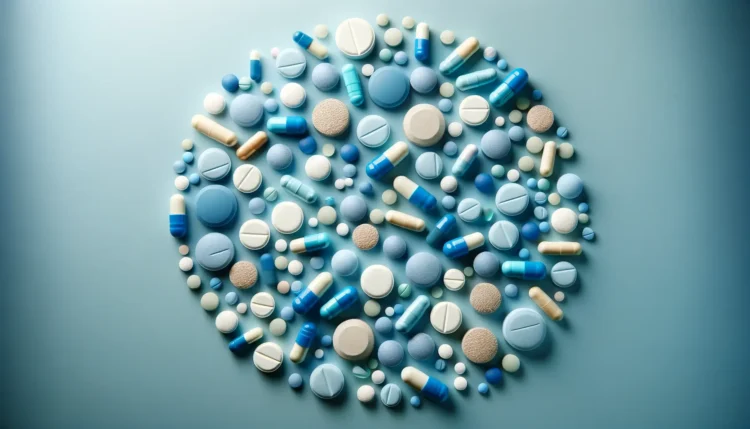Erectile dysfunction (ED) affects a staggering number of men worldwide. It is estimated that over 30 million men in the United States alone experience this condition (CDC).
ED can have a significant impact on a man’s quality of life, relationships, and overall well-being, making it a matter of utmost importance to find effective treatment options.
When it comes to treating ED, there are several medications available, but three popular choices stand out: sildenafil (Viagra), tadalafil (Cialis), and vardenafil (Levitra).
These medications belong to a class of drugs called phosphodiesterase type 5 (PDE5) inhibitors, which work by relaxing penile erectile tissues to enhance the ability to achieve and maintain an erection.
In this article, we will compare the potency, mechanism of action, speed of onset, duration of effectiveness, side effects, drug interactions, patient preferences, and satisfaction rates of sildenafil, tadalafil, and vardenafil, helping you make an informed decision about which medication may be best for you. Let’s dive in!
Key Takeaways:
- Sildenafil, tadalafil, and vardenafil are FDA-approved medications for treating erectile dysfunction.
- These medications belong to the class of drugs called PDE5 inhibitors.
- Each medication has its own unique potency, speed of onset, and duration of effectiveness.
- Common side effects may include headaches, indigestion, and nasal congestion.
- Patient preferences can vary, and it may be necessary to try different medications to find the best fit.
Mechanism of Action
Both sildenafil and tadalafil are PDE5 inhibitors, which means they block the action of the phosphodiesterase type 5 enzyme in the body. By inhibiting this enzyme, both medications increase blood flow to the penis when a man is sexually aroused.
It is important to note that these drugs do not increase sexual desire but rather enhance the ability to achieve and maintain an erection by improving blood flow to the penis.
Patients should understand that the success rate of these medications may vary based on the severity of erectile dysfunction (ED), and dose adjustments may be necessary over time.
Speed of Onset
When it comes to fast-acting erectile dysfunction (ED) medications, both sildenafil and tadalafil are popular choices. These medications typically take approximately 30 to 60 minutes to start working, providing men with the ability to achieve and maintain an erection when sexually stimulated.
It’s important to note that sildenafil reaches its peak concentration in the blood after about one hour, while tadalafil reaches its peak after two hours. Therefore, it is recommended to take these medications about one to two hours before engaging in sexual activity.
However, it’s worth mentioning that the time it takes for these drugs to take effect may vary between individuals. Additionally, certain factors can influence the effectiveness of these medications. Sildenafil, for example, may be less effective if taken after a large meal, while tadalafil is not affected by food intake.
Considering these factors, sildenafil may be more suitable for individuals with a more predictable sex life, while tadalafil may be a better option for those who are dating or engaging in spontaneous sexual activity.
Duration of Effectiveness
When it comes to the duration of effectiveness, sildenafil and tadalafil offer distinct advantages for individuals seeking treatment for erectile dysfunction (ED).
Sildenafil, commonly known as Viagra, remains effective for four to six hours after ingestion. This means that individuals can experience improved erectile function within this time frame. Sildenafil’s relatively shorter duration of effectiveness may be suitable for those who prefer a shorter window of opportunity for sexual activity.
Tadalafil, on the other hand, can enable erections for up to 36 hours, making it the longest-lasting ED medication available. This extended duration is particularly beneficial for individuals with lesser degrees of ED or younger patients, as it allows for increased spontaneity and flexibility in sexual encounters.
It is important to note that while tadalafil provides a prolonged effect, it should not be mistaken for an increase in sexual desire. The medication allows for a better erection only when desired and sexual stimulation is present.
It is essential for patients to be aware that the duration of effectiveness may vary between individuals. Previous experiences with the medications can serve as a guide. It is recommended to consult with a healthcare provider to determine the most suitable medication and dosage based on individual needs and preferences.

Note: The image above visually represents the prolonged effectiveness of ED medications.
Side Effects
Both sildenafil and tadalafil, commonly used medications for erectile dysfunction (ED), are generally well-tolerated and have few severe side effects. It is important to be aware of the potential risks associated with these drugs.
“The risk of side effects may be higher in individuals with certain eye problems, cardiovascular or metabolic diseases, and those who smoke.”
Sildenafil, also known as Viagra, can cause common side effects such as headaches, nausea, flushing, stuffy nose, indigestion, dizziness, and a blue hue to vision. In rare cases, loss of vision can occur, which should be reported to a healthcare professional immediately.
Tadalafil, also known as Cialis, can cause common side effects including headaches, indigestion, nasal congestion, back pain, cough, and upper respiratory tract infections.
It is worth noting that recent studies have shown that both sildenafil and tadalafil may reduce the risk of early death from heart disease. However, it is important to remember that these drugs are not a treatment for heart disease and should not replace any existing cardiovascular therapies.
Risk Factors for Side Effects
While sildenafil and tadalafil are generally safe, there are certain risk factors that can increase the chances of experiencing side effects. Individuals with certain eye problems, such as retinitis pigmentosa, should exercise caution when using these medications.
Similarly, individuals with cardiovascular or metabolic diseases, such as high blood pressure or diabetes, may be at a higher risk for side effects. Smoking can also increase the risk of experiencing adverse effects.
If you experience any side effects while taking sildenafil or tadalafil, it is important to consult with your healthcare provider. They can provide guidance on whether the medication needs to be adjusted or if an alternative treatment option should be considered.
Remember, your healthcare provider is the best resource for understanding the risks and benefits of these medications based on your individual health profile. Always follow their guidance for the safe and effective use of ED medications.
Drug Interactions
In order to ensure the safe use of ED medications, it is crucial for patients to inform their healthcare providers about any medications they are currently taking.
Both sildenafil and tadalafil have the potential to interact with certain drugs, which can have serious consequences. It is important for patients to be aware of the precautions while taking these medications to avoid any potential drug interactions.
One important precaution is to avoid taking ED medications, such as sildenafil and tadalafil, along with nitrates. Nitrates are commonly used to treat chest pain or angina, and when combined with ED medications, they can cause a sudden drop in blood pressure that can be life-threatening.
This combination can increase the risk of heart attack or stroke, so it is crucial to avoid using nitrates while taking sildenafil or tadalafil.
Another drug to avoid when using ED medications is recreational drugs known as “poppers.” Poppers are often used as a party drug or for enhancing sexual experiences.
However, when taken with sildenafil or tadalafil, poppers can also cause a dangerous drop in blood pressure and lead to severe cardiovascular complications.
To ensure the safe use of these medications, it is recommended that patients speak to their healthcare provider or pharmacist about any potential drug interactions. They can provide valuable guidance on the safety of using sildenafil or tadalafil with other medications, and they may suggest alternative options if necessary.

Precautions to take while taking sildenafil and tadalafil:
- Avoid taking nitrates along with these medications
- Avoid recreational drugs known as “poppers”
- Inform healthcare provider about all medications being taken
By following these precautions and having open communication with healthcare providers, patients can safely and effectively use sildenafil and tadalafil to treat their erectile dysfunction.
Patient Preferences and Satisfaction
When it comes to choosing the right medication for erectile dysfunction (ED), patient preferences play a crucial role. Individual experiences with ED medications can vary, and finding the best fit for each person’s unique circumstances is key.
Studies have shown that slightly more men achieve a satisfactory erection with sildenafil, commonly known as Viagra. On the other hand, tadalafil, which is the active ingredient in Cialis, is often preferred by more men due to its longer duration of effectiveness.
Factors such as the individual’s sex life and the presence of any side effects can influence patient preferences. Each medication has its own advantages and considerations, and it is recommended that patients try both sildenafil and tadalafil separately to determine which works best for them with the fewest side effects.
| Medication | Patient Preference | Satisfaction Rates |
|---|---|---|
| Sildenafil (Viagra) | Slightly more men achieve satisfactory erection | High satisfaction rates |
| Tadalafil (Cialis) | Often preferred due to longer duration of effectiveness | High satisfaction rates |
| Vardenafil (Levitra) | Preference may vary among individuals | High satisfaction rates |
The use of generic versions has made it more affordable for patients to explore different medications and find the best fit for their needs. It is important for patients to discuss their preferences with a healthcare provider to ensure the most effective and well-tolerated medication is chosen to improve erectile function and enhance overall sexual satisfaction.
Conclusion
When seeking the best medication for erectile dysfunction (ED), it is crucial to consult a healthcare provider to discuss the unique benefits and risk profiles of sildenafil, tadalafil, and vardenafil.
Each medication has its own characteristics, and what works well for one patient may not be suitable for another. Fortunately, with the availability of generic versions, patients have the opportunity to try different medications and find the one that works best for their specific needs.
In the process of choosing between sildenafil, tadalafil, and vardenafil, it is important to consider factors such as onset of action, duration of effectiveness, and individual preferences.
Sildenafil and tadalafil are fast-acting ED medications, typically taking effect within 30 to 60 minutes.
However, sildenafil lasts for approximately four to six hours, while tadalafil offers a longer window of effectiveness, up to 36 hours. This longer duration may be especially beneficial for individuals with a more spontaneous sexual lifestyle.
It is vital to note that these medications do not increase sexual desire but rather assist in achieving and maintaining an erection when sexual stimulation is present. Adverse effects are possible with any medication, and patients should be aware of potential side effects. If any side effects occur, it is recommended to switch to another medication or seek medical attention if the side effects are severe or persistent.
The ultimate goal is to find the most effective and well-tolerated medication to improve erectile function and enhance overall sexual satisfaction.
Through open communication with a healthcare provider, individuals can make an informed decision and embark on a personalized treatment plan that aligns with their needs and preferences, bringing relief and restored confidence in their intimate relationships.
FAQ
What are the differences between sildenafil, tadalafil, and vardenafil?
Sildenafil (Viagra), tadalafil (Cialis), and vardenafil (Levitra) are all medications used to treat erectile dysfunction (ED). While they belong to the same class of drugs called phosphodiesterase type 5 (PDE5) inhibitors, there are some differences in their effectiveness, onset of action, duration of effectiveness, and side effects.
How do sildenafil and tadalafil work?
Both sildenafil and tadalafil are PDE5 inhibitors that work by blocking the action of an enzyme called phosphodiesterase type 5 in the body. By inhibiting this enzyme, they increase blood flow to the penis when a man is sexually aroused, helping to facilitate an erection.
How long does it take for sildenafil and tadalafil to start working?
Sildenafil and tadalafil typically take about 30 to 60 minutes to start working. Sildenafil reaches peak concentration in the blood after about one hour, while tadalafil reaches peak concentration after two hours.
How long do sildenafil and tadalafil last?
Sildenafil remains effective for four to six hours, while tadalafil can enable erections for up to 36 hours. It’s important to note that the duration of effectiveness may vary between individuals and previous experience with the drugs can serve as a guide.
What are the common side effects of sildenafil and tadalafil?
Common side effects of sildenafil include headaches, nausea, flushing, stuffy nose, indigestion, dizziness, and a blue hue to vision. Common side effects of tadalafil include headaches, indigestion, nasal congestion, back pain, cough, and upper respiratory tract infections.
Are there any drug interactions with sildenafil and tadalafil?
Yes, both sildenafil and tadalafil can have interactions with certain drugs. Patients should not take these medications if they are using nitrates, as this can cause a sudden drop in blood pressure.
Recreational drugs known as “poppers” should also be avoided. It’s important to speak to a healthcare provider or pharmacist about potential drug interactions.
Which medication is better for erectile dysfunction?
The choice between sildenafil, tadalafil, and vardenafil depends on individual preferences and experiences.
Studies have shown that slightly more men achieve a satisfactory erection with sildenafil, while tadalafil is preferred by more men possibly due to its longer duration of effectiveness. It is recommended to try both medications separately to see which works best with the fewest side effects.
How should I choose between sildenafil, tadalafil, and vardenafil for ED treatment?
When considering the use of these medications, it is important to discuss the unique benefits and risk profiles of each with a healthcare provider. There is no single medication that should be prescribed to every patient, and individual preferences and experiences may vary.
With the availability of generic versions, it is often possible to try different medications to find the best fit for one’s unique circumstances.








